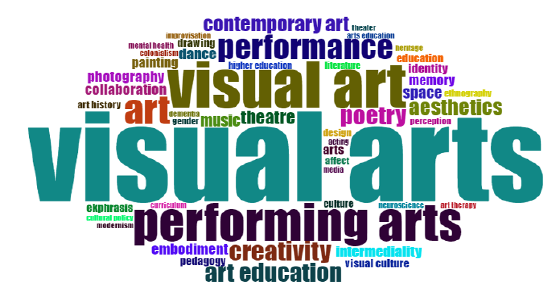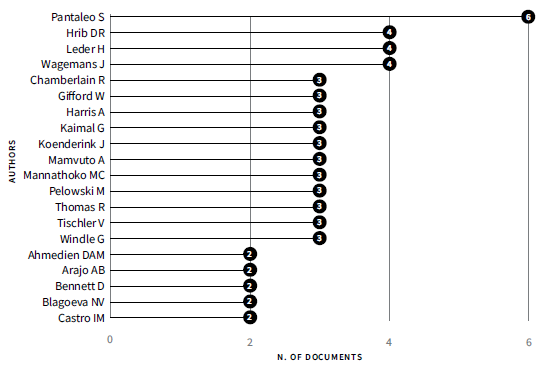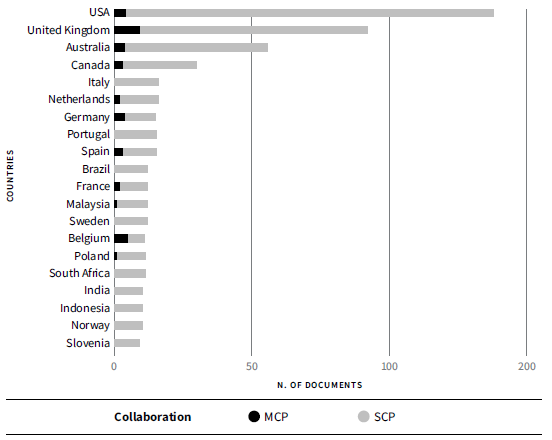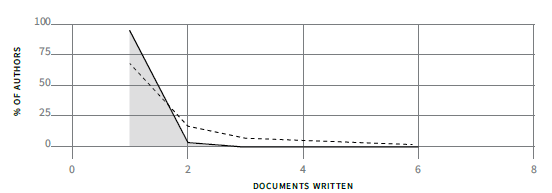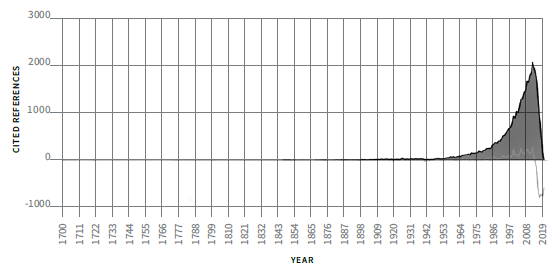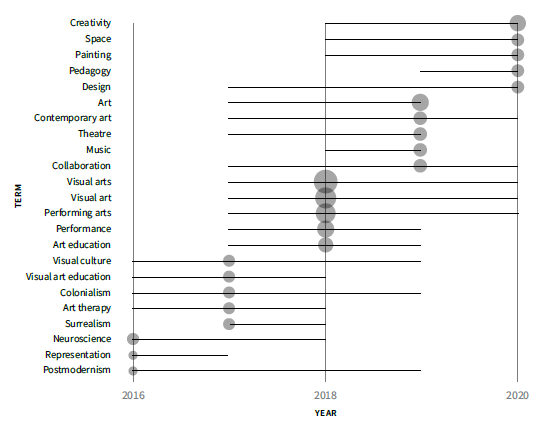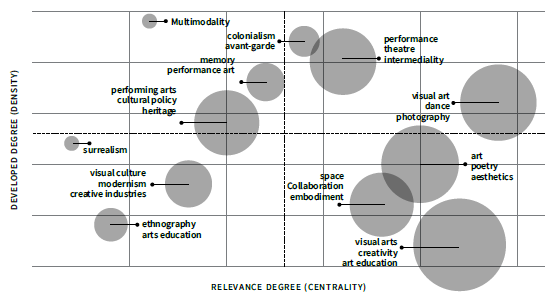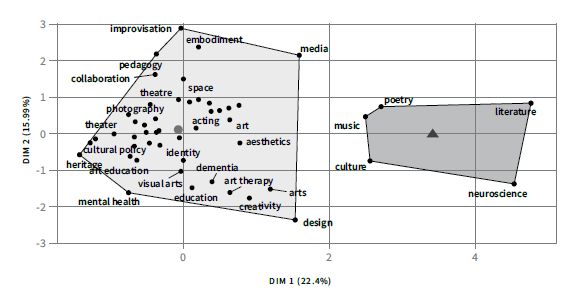Introduction
Art history has substantially influenced the development of society and helped us understand each period in history while marking a milestone as each style appeared. The beginning of what now can be called art dates to 30 000 years ago, during prehistoric times, when the first evidence of art exhibitions through cave paintings was emerging worldwide (Crawshaw, 2020; Restrepo-Arango, 2019). Thus, the first art exhibitions represent the appropriation of a universal language for humanity and a sense of awareness as individuals and social beings.
The impact of art on society can be seen in the mutual relationship established between culture and art, through which economic, political, and social aspects are shown. The same applies to traditions and customs inherent to a specific culture through artistic expression mechanisms and different symbolic representations (González-Zamar; Abad-Segura, 2021). Additionally, Green (2021: 1) states that "arts practice generates knowledge about the world, about social issues, the human condition and knowledge about art itself".
Art as a discipline is composed of several axes, including visual and performing arts. On the one hand, visual arts are considered a representation of art that enables the expression of that affecting people, allowing the artist to capture emotions, feelings, and the perception of the world through creation and imagination (González-Zamar; Abad-Segura, 2021; Pflüger, 2021). On the other hand, performing arts encompasses all forms of expression that may involve staging, such as theater, opera, dancing, music, circus art, among others (Chen; Tang, 2021; Gómez-Hernández; Ramos-Ramírez; Espinal-Monsalve, 2020).
Disciplines such as visual and performing arts face a great challenge in relation to this research, as evidence and non-quantifiable aspects pose an epistemological obstacle for academics (Zhao; Minns, 2019). Quantifiable or methodological processes do not exactly characterize art. In fact, it might be said that for decades art was set apart from the scientific method (Mateos-Martín; Sedeño-Valdellos, 2021). However, higher education and the need to grow within sciences imply that academics in this discipline must adapt to new parameters and be active players in the generation of new knowledge (Castañeda, 2015). Until now, scientific production in Scopus on visual and performing arts is scarce; additionally, a few journals are focused only on scientific communication in these areas (Rubio; Caerols, 2018).
Despite the abovementioned, in the university sphere, research on visual arts appears to be growing, with an increasing interest from the scientific community and academia (González-Zamar; Abad-Segura, 2021). This is a positive aspect for universities, considering that to be accepted in the competitive world of higher education, developing research that causes impact as well as guarantees research ethics and return of investment is necessary (Zhao; Minns, 2019). For example, bibliometric analysis has been conducted on several studies in relation to the current COVID-19 situation. This topic has rapidly expanded since the beginning of the pandemic at the end of 2019, and several articles aimed to provide information on this rapidly increasing topic (Gao et al., 2021).
In the art discipline, several works have been conducted to assess documentary production on specific art topics or its relationship with other disciplines and the journals devoted to art publication. Dharmani, Das and Prashar (2021) performed a bibliometric study on creative industries identifying that this area is barely emerging and its beginning has been dominated by a few authors, sources, and countries.
Meanwhile, the study conducted by González-Zamar and Abad-Segura (2021) on the research of visual arts within the educational sphere found an important increasing trend, evidenced in 70 % of publications from the last ten years. Furthermore, emerging research lines are identified in this study for groups and research networks seeking to adapt to this new topic to generate new knowledge that causes an impact. These research lines were the following: abstract art, abstract painting, antiques, fresco painting, iconicity, image statistics, reconstruction, Renaissance, and sound art (González-Zamar; Abad-Segura, 2021).
Furthermore, Lee (2020) sought to discover patterns in arts and physical therapy research in Korea during 2001-2019. In this research work, it has been found that authors tend to work alone, and co-authorship occurs mainly among relatively important authors. Moreover, it has been found that in the Art category, international cooperation is higher than in categories such as Design and Physical Therapy.
Santi et al. (2021) performed a bibliometric study with data obtained from Scopus, with the aim of mapping research trends within the field of STEAM (Science, Technology, Engineering, Arts, and Math), by means of the VOSviewer software. It was found that only 91 % of authors have contributed with one article, while 8 % have contributed with two publications, and the remaining 1 % has published three. Furthermore, South Korea is the most productive country.
In another bibliometric study conducted by Uribe-Bahamonde (2020), relation and bibliometric indicators were used to analyze the content and history of the KEPES journal during 2004-2019. This journal is known for disseminating research and considerations that are dealt with in different national and international academic institutions. The results show that the authors, who publish articles in this journal, focused on visual design and tended to publish works individually, having local and limited collaborative networks.
Wright and Liang's (2019) study on arts and sustainability found that despite the low number of published articles, there is a significant increase in the number of journals focused on publishing works related to this topic. Furthermore, two important aspects were identified in relation to the production and dissemination dynamics of works in this area. First, there is no evidence of the existence of a leader in the production of these topics, and second, most of the articles are published in interdisciplinary journals, especially those related to sustainability and education.
In Su, Li, Kang's (2019) bibliometric study on intangible cultural heritage, aspects such as little cooperation among researchers, institutions, and countries, as well as highly productive authors but with low citation indexes, and documentary concentration in a few countries, were found. This study, as well as those previously reviewed, show that research fields associated with art face great challenges to become a solid discipline within the sphere of scientific production (Dharmani et al., 2021; González-Zamar; Abad-Segura, 2021; Lee, 2020; Santi et al., 2021; Su et al, 2019; Uribe-Bahamonde, 2020; Wright; Liang, 2019).
Meanwhile, bibliometric studies are a way to assess indicators related to the research on different disciplines. These studies seek to analyze the different knowledge communication media (books or articles) through statistical methods in which data and characteristics inherent to publications, such as citations, references, topics, institutional affiliations, among others are shown (Saravanan; Rajeswari; Kumar; Rajasimman; Rajamohan, 2022; Ullah; Ameen, 2021). These bibliometric studies help make inferences or interpretations estimating the state of this discipline in relation to others or itself, what is relevant for a specific segment of the scientific community, and how scientific collaboration networks are established (Ali; Park; Kwon; Chae, 2019; Castanha; Grácio, 2014).
Lotka's law is among the bibliometric indicators used for this study. This indicator establishes a relation between scientific production, the number of authors, and the number of articles (Chaturbhuj; Batcha, 2020). Thus, this indicator establishes an inverse relationship between the number of authors and the number of articles published (Chin; Chew, 2021). Furthermore, the Price index, which calculates the percentage of references not older than five years, was used (Ardanuy, 2012; González-Pérez; Peralta-González; Meneses-Placeres, 2019; Rodríguez; Arbinaga, 2018).
Bradford's law was used in relation to the assessment of the journals distribution. This law allows to estimate the number of available articles on a topic during a specific time and identifying production per area. This is presented through a semi-logarithmic graph showing the total of articles accrued R (n) in relation to the number of journals n, where the most productive sources are contained in the core or initial nonlinear area of the curve. It is necessary to be precise concerning the total number of sources and articles for the estimation to be useful (Praunlich; Kroll, 1978). It has been previously proven that this law is provable even when observing the behavior of emerging fields during the first stages (Peritz, 1990).
In short, it is necessary to develop studies that provide results and interpretations in the light of the scientific path of visual and performing arts. Although this area lacks bibliometric studies, it is essential to know the current state of production indexes to plan and identify future challenges and aspects to be strengthened. For such purposes, bibliometric studies are used. These studies have become popular, given their dynamics when analyzing different disciplines (Hood; Wilson, 2001).
This study was conducted following a bibliometric approach where quantitative methods (indicators and mathematical models) were used, aiming to carry out a bibliometric analysis within the categories visual arts and performing arts indexed in Scopus during 2016-2020. This study identifies the extent and evolution of scientific production of these disciplines at a global scale.
Methodology
The bibliometric analysis protocol consisted of reviewing the articles belonging to the Scopus database that contained the information for the study (list of authors, related bibliography and that could be downloaded). The analysis was carried out with the journals indexed in Scopus, taking into account that it is a free access database and using the bibliometric information provided through the Scimago Journal & Country Rank portal, which enables review by field of knowledge, level of scientific production, number of authors, etc. In addition, another factor for which the analysis was carried out with the Scopus database was the high-impact journals that it indexes in its different categories.
The bibliometric analysis was carried out using RStudio free software and its library biblioshiny, using the bibliometrix package, which enables to execute bibliometric studies from two perspectives:
1) Levels of analysis: sources, authors, and documents.
2) Structural analysis: concept, intellectual, and social structure.
Before the beginning of the analysis, research on the Scopus database was carried out. The following inclusion criteria were considered:
1) Main topic of the study: visual and performing arts. Therefore, the keywords to include on the search query were visual art and performing art. The results cover topics related to visual and performing arts, which is why the logical operator OR was used.
2) The search should have covered the last five years.
3) Given the importance of the search, only articles were selected.
4) The filter topic was art.
The search was carried out on October 18, 2021, by means of the following search query:
TITLE-ABS-KEY ("visual art" OR "performing art") AND PUBYEAR > 2015 AND PUBYEAR < 2021 AND (LIMIT-TO (DOCTYPE , "ar" )) AND ( LIMIT-TO ( SUBJAREA , "ARTS" ))
Note: DOCTYPE ar, refers to articles.
According to the obtained records, the following four phases were implemented:
Identification
The identification phase comprised collecting information used from the Scopus database. This database collected a total of 1342 articles published in 650 journals that publish works on the field of interest and are known worldwide. Articles published from 2016 to 2020 in journals present in countries comprising the North American and Ibero-American area were used.
Filtering
A review of the bibliographic references was carried out in the filtering phase, and those documents that were not reviewed for information gathering were dismissed.
Eligibility
The eligibility phase consisted of checking the origin of journals and whether the articles were related to the topics of visual and performing arts.
Including
The including phase comprised building a database. Later, a descriptive biblio-metric data analysis was conducted, where a series of bibliometric indicators were applied. This analysis is related to the number of scientific works published, their annual distribution differentiating North America and Ibero-America, the authors' productivity, the Lotka productivity index, the scientific cooperation, the cooperation index, and the research topic of the scientific works.
As for the study of bibliographic references of each article, the mean of the number of references per article was studied. Furthermore, an obsolescence study (Price index) was carried out, as well as an analysis of the journals that have continuously published works for the last five years. Finally, a search on Scimago Journal and Country Rank (SJR) was carried out on Scopus on the participation of Latin America in the categories of visual and performing arts.
Results
Figure 1 shows the results obtained during the methodological process of information search. Based on the results produced by the search on Scopus (1342 articles), the database was downloaded in BibTeX format to process it on RStudio. This software initially delivers brief information on the existing data, and such information can be seen in Table 1. This enables briefly yet thoroughly describing relevant data obtained concerning the type of documents, their content, authors, and co-authors, making the interpretation of necessary data easier to create a global idea of this discipline in terms of research during the selected period.
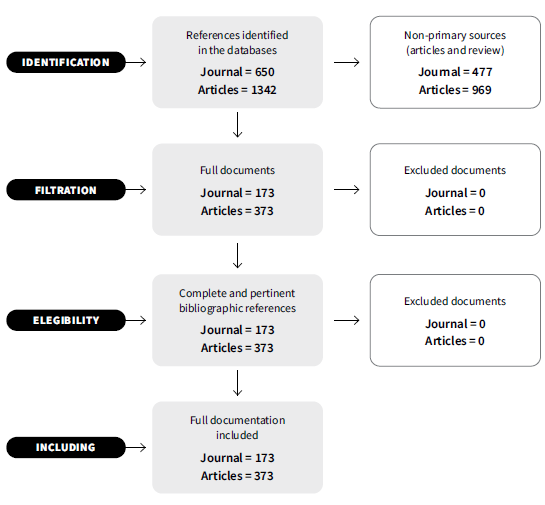
Source: own elaboration.
Figure • 1 Results from the methodological information research, recovery, and selection process for this analysis
Table • 1 Summary of the search carried out on Scopus
Source: own elaboration.
Several important aspects can be seen in Table 1. The number of single-author documents is 919, which shows a very low cooperation index for the creation of research documents, as the total amount is 1342. The co-authors' index per document is calculated as the average number of co-authors per article. In this case, the index considers how many times the author appears, while for authors per document, the author is considered once, even though the articles published are more than one. Therefore, the authors per document index ≤ co-authors per document index. Meanwhile, the cooperation index considers co-authors per article, calculated only with the set of articles from several authors and in this case, the cooperation index is 2.74.
A cloud made up of words can be seen as a result of the search. This cloud organizes the most relevant words of the research by cluster. Clearly, the terms visual art and performing art present the highest content compared to the rest of the keywords found in the documents. Other words such as creativity, educational art, performance, art, music and more are emphasized (see Figure 2).
Journals, their accrued production during 2016-2020, and the divisions per area according to Bradford's Law can be seen in Figure 3. Furthermore, Figure 3 shows that the performing arts and visual arts journals with the highest productivity are those belonging to zone 1 (48 journals/443 articles), of which 17 are journals from the North American and Ibero-American regions that present an accrued production of 36.7 % of all articles from that area.
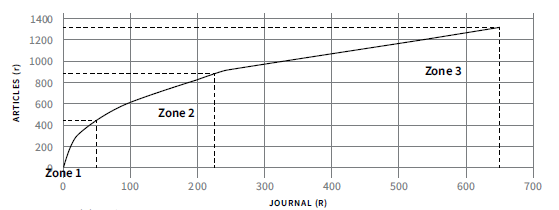
Source: own elaboration.
Figure • 3 Journals and their production in relation to articles published in the last 5 years
A graphic representation of the number of journals published each year and the number of journals that keep publications in contrast to years before is made considering journals that have published articles in 2016. Figure 4 shows this relationship with journals at a global scale and how this works in the North American and Ibero-American regions.
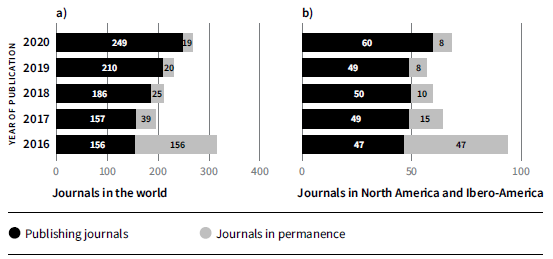
Source: own elaboration.
Figure • 4 Number of journals according to the year of publication: a) journals in the world, b) journals in the North America and Ibero-America regions
The most relevant authors from the journals and articles previously mentioned are shown in Figure 5. Another important aspect to be considered from the bibliometric study is the existing cooperation between countries and authors. In Figure 5, inter-country cooperation (SCP) is presented in blue and cooperation between several countries is presented in orange. Meanwhile, Figure 6 summarizes the cooperation between countries.
Regarding the authors' scientific productivity (see Table 2), it can be seen that 640 authors published only one article (productivity index equals 0), 16 published two articles, and four published three articles. In the column Apparent Works, the result of the number of articles per number of authors is shown, and in the last column, the decimal logarithm representing the number of articles is presented. The result of the quotient between the total number of apparent works and the total number of authors is 1.04, which is the number of works by author.
Table • 2 Author's scientific productivity and Lotka's Law
| Number of Articles (n) | Number of Authors | % Number of Authors | Apparent Works | Lotka's Law (Productivity Index) (lg10 n) |
|---|---|---|---|---|
| 1 | 640 | 97.0 % | 640 | 0.00 |
| 2 | 16 | 2.4 % | 32 | 0.30 |
| 3 | 4 | 0.6 % | 12 | 0.48 |
| 660 | 684 |
Source: own elaboration.
Lotka's productivity indices (n) are distributed between three productivity levels, according to the data presented in the last column in Table 2. Productivity levels or indices (PL) can be clearly seen in Figure 7, where 640 (97 %) authors have PL = 0 (low productivity) appearance. Meanwhile, there were 20 (3.0 %) authors having 0 < PL < 1 (medium productivity). The total number of authors found in the 373 articles that have been published was 660.
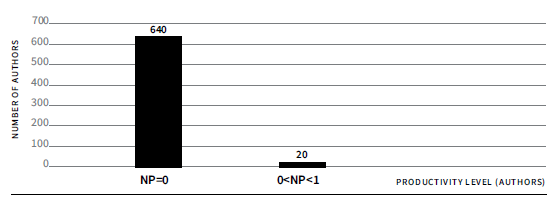
Source: own elaboration.
Figure • 7 Productivity levels of authors that publish works in North American and Ibero-American journals
Lotka's productivity index, which represents the decimal logarithm of the number of publications groups small producers having only one work published and an index equal to 0; medium producers (2-9 published works) having a Lotka's law between 0 and 1; and large producers (10 or more works published), having a productivity index equal to or greater than 1. Such index is shown in Figure 8.
Figure 9 shows the number of citations referenced per year, where it can be observed that before the year 2000, the number of citations referencing topics related to visual and performing arts was increasing, reaching a peak of 2000 citations. Although, by 2008, this number began to decrease, disappearing by 2019.
To deeply understand the use of references on these topics, Table 3 shows the Price index obtained for each year according to the number of bibliographic references used in articles published during those years. The number of articles published each year, the number of references included in those articles, the number of references that are five years old or less in relation to the year of the article's publication, and the Price index are shown in the Table 3. The result varies, but generally, the Price index is low, and the total percentage of references according to this index is 26.3 %.
Table • 3 Price index (% of references being five years old or less)
| Year | Number of articles | Number of references | References < 5 years | Price index (%) |
|---|---|---|---|---|
| 2016 | 72 | 1555 | (2016-12) 415 | 26.7 % |
| 2017 | 70 | 1290 | (2017-13) 295 | 22.9 % |
| 2018 | 63 | 1172 | (2018-14) 316 | 27.0 % |
| 2019 | 70 | 1148 | (2019-15) 303 | 26.4 % |
| 2020 | 98 | 3290 | (2020-16) 898 | 27.3 % |
| Total | 373 | 8455 | 2227 | 26.3 % |
Source: own elaboration.
Figure 10 shows the trending topics over the years in contrast to Figure 9 which shows these topics' evolution, emphasizing topics highlighted over the last five years concerning visual and performing arts. Figure 11 shows a thematic map with four important sets of topics addressed in this research. The map is divided into four quadrants, each representing an important topic. The first quadrant shows central topics-the main topics of the research-while the second quadrant shows peripheral topics related to the main ones, but these do not have a strong presence. The third quadrant illustrates emerging or declining topics. Finally, the fourth quadrant reveals the basic topics and topics cross-sectional to the research.
The tool enables a factorial analysis of the documents. A multiple correspondence analysis was conducted to determine the closeness between the different categories. Good closeness between categories implies a high association between these categories. Another interpretation of this analysis is that the farther the category of origin (0.0), the stronger the force of association between these categories. Another interpretation of this graph is that opposite origin categories show a negative association. Figure 12 has two categories, one presented by the red circle and the other by the blue triangle. Each category contains a set of statistically associated words.
Finally, a search on SJR was made to measure Latin America's involvement in the visual and performing arts categories in Scopus. This search showed that the presence of journals being referred to the topic in Latin America is weak. According to SJR, during the last three years, ten journals participated in publications on topics related to visual and performing arts (see Table 4). Five countries participated in Latin America (Chile, Colombia, Brazil, Mexico, and Argentina) with a total of 713 documents and 114 citations, which again shows the low participation and citation index of such documents. It is important to consider that of the ten journals, only the KEPES journal is indexed in the visual and performing arts categories, that is to say, that the remaining nine journals correspond to two or more categories.
Table • 4 Participation in Latin America
| Ranking | Title | SJR quartile | Total number of documents (last three years) | Total number of citations (last three years) | Country |
|---|---|---|---|---|---|
| 1 | Boletín del Museo Chileno de Arte Precolombino | Q1 | 52 | 42 | Chile |
| 2 | KEPES | Q1 | 88 | 16 | Colombia |
| 3 | Revista 180 | Q1 | 64 | 14 | Chile |
| 4 | ARQ | Q1 | 139 | 13 | Chile |
| 5 | Cuadernos de Música, Artes Visuales y Artes Escénicas | Q2 | 77 | 9 | Colombia |
| 6 | Discursos Fotográficos | Q2 | 79 | 7 | Brazil |
| 7 | Co-herencia | Q3 | 89 | 8 | Colombia |
| 8 | Boletín de Estética | Q3 | 17 | 0 | Argentina |
| 9 | Anales del Instituto de Investigaciones Estéticas | Q4 | 45 | 3 | Mexico |
| 10 | Aisthesis | Q4 | 63 | 2 | Chile |
Source: own elaboration.
Discussions and conclusions
This study conducted a bibliometric analysis of the visual and performing arts categories indexed in Scopus to identify the extent and evolution of these fields. The findings enabled a visualization of the state of scientific production on visual and performing arts over the last five years (2016-2020), which indicates a growing trend. However, since 2017, there has been an increase in documentary production year after year, yet, the level of growth is not significant. This continuous growth can be explained due to the lack of collaborative networks for co-authorship, given factors related to scarce international cooperation (IC), authors' low impact factor (IF), or non-productive regions.
Collaborative research networks are a key element for the productivity level to grow. These networks lead to the construction of high-quality documents and higher visibility of the scientific community (Lee; Bozeman, 2005; Samitas; Kampouris, 2018). The findings of this study showed that 919 documents out of 1342 were single-authored, which means that only 31.5 % of published documents were written by several authors. This shows an authors' collaboration index of 2.74, representing a lack of collaborative networks, which may, in turn, restrict the level of documentary production.
Lotka's law applies to this study, which shows a higher number of published documents by a small number of authors. According to this, a concerning aspect is that 97 % of authors have low productivity, that is, they have only published one article over the five years analyzed. Meanwhile, only 20 authors were identified as medium productive (two or three articles). This can obstruct processes such as research network construction or IC due to low levels of authors' impact.
By means of network analysis, according to Xu and Chang (2020: 3), this enables "visually presenting the influence of research and can reveal researchers' collaboration patterns and actions at the level of individual, institution, or geography". Furthermore, denser collaboration networks positively affect the authors' ability to innovate and create, which results from the need for constant exchange and varied flow of information (Forti; Franzoni; Sobrero, 2013). Network density is also related to trust, intellectual enrichment, and cooperation. Furthermore, dispersed networks have the same effect as dense ones, positively affecting the work of the whole team (Pauli; Basso; Lopes; Bilhar, 2019).
Regarding citation, results show variability in the visual and performing arts categories. Although in 2008, the amount of 2000 citations was exceeded, the following years were not equally productive and, in turn, a sudden decrease was perceived, reaching 0 citations in 2019. This shows that article visibility was affected and, therefore, the impact decreased. This may be reflected as a restriction of potential growth in international co-authorship as in documentary production. Thus, the importance of strengthening collaboration networks between researchers lies in the increase of impact and visibility of scientific production as well as in emerging research groups between teachers, higher education institutions, or research institutions (Bordons; Aparicio; González-Albo; Díaz-Faes, 2015; Velasco; Gregorio; Alfonso, 2021).
Meanwhile, the results of this bibliometric analysis reveal how topics related to visual and performing arts have transformed over the years. Topic identification was made through the trend analysis technique based on keywords (Wang; Cheng; Lu, 2014). Thus, variation between 2016 and 2020 is shown. In the former year, a higher trend toward topics related to neuroscience, postmodernism, and representation is shown, whereas, in the latter, topics such as pedagogy, creativity, space, painting, and design are emphasized. Moreover, Figure 10 shows the topic evolution in terms of arts and visual arts as well as how words such as ekphrasis and love have transcended.
Several authors have stated that the acknowledgment of emerging research topics enables the development of studies with an innovative and useful approach, favoring the projects' funding due to the potential impact that represents addressing new topics (Lu et al., 2021; Xu; Winnink; Yue; Zhang; Pang, 2021). Furthermore, identifying emerging topics can foster the acquisition of economic resources for researchers focused on local development, especially in developing countries. In addition, this increases the number of topics addressed. Generally, this type of research depends on international funding from IC. Thus, betting on tendencies of international interest and adapting them to local territories would be greatly useful for strengthening networks, achieving goals, and receiving academic acknowledgment (Monge-Nájera, 2021).
Furthermore, another factor that seems to be affecting the level of production in the categories of visual and performing arts in Scopus is IC. Results obtained from this study show the need to foster cooperation between countries because most publications are the result of local instead of IC (see Figure 5). There is a high trend for collaboration between the United States, Canada, and Germany. Simultaneously, the United States cooperated with Spain, which cooperated with France, Canada, and the United Kingdom. Collaboration between countries is rare, and there is no evidence of Latin American countries' participation. It is important to emphasize that the citation index of publications with IC is higher in contrast to that of publications lacking IC (De Moya-Anegón; Guerrero-Bote; Lopez-Illescas; Moed, 2018). Similarly, results reveal that an influential component in documentary production is the lack of productiveness exhibited by large territories, such as the African continent and Russia.
In relation to journals, this study showed that there is a higher documentary production in a smaller number of scientific journals. It is important to emphasize that North American and Ibero-American regions have low participation in the most productive area, which can be related to the low visibility of published documents. Another phenomenon identified in the journals' production dynamic is a low percentage of journals that remain actively publishing year after year.
Meanwhile, Latin America has ten scientific journals focused on the topic, six of which are classified in Q1 (4) and Q2 (2), representing a promising future for the region regarding quality in documentary production on the topics of visual and performing arts. Furthermore, it is important to consider that publications in journals with the maximum quality standards favor authors' visibility and impact (Gregorio-Chaviano; Limaymanta; López-Mesa, 2020; Pérez-Rodríguez; García-Ruiz; Aguaded, 2018; Rivas-Castillo, 2020; León; Agámez; Ordóñez; Castillo, 2022). However, the need to increase the number of journals focused only on the categories of visual and performing arts is evident. This is to foster the development of the discipline and the scientific growth of the region.
To conclude, the categories of visual and performing arts indexed in Scopus have managed to grow year after year, which is a factor that shows a trend toward research development. Regarding the resulting extent of this growth, it is important to emphasize the need to foster the impact of research given that this does not only positively affect the author and the possibility of obtaining resources for future research (Li; Liao; Yen, 2013) but also allows reducing barriers between authors as a consequence of the centrality of an author who received acknowledgment due/thanks to its impact (Lee, 2020; Li et al., 2013).
Furthermore, important aspects that should be considered when seeking greater growth and impact on the categories of visual and performing arts in Scopus were identified. The following aspects should be considered as meaningful challenges for the purposes of fostering and strengthening arts scientific production: greater IC, solid structure and wide collaborative research networks, research funding increase, greater coverage of emerging topics, and activation of territories having poor or no percentage of production.
Finally, it should be noted that this research is focused on bibliometric analysis carried out through the data obtained in the Scopus database. Therefore, it does not contemplate the methodological aspects of the investigations. This means that it cannot determine whether the articles taken into account are part of research adapted to methodologies of the arts (for example, staging) or if they are adapted to the scientific method required by journals with high scientific impact. Given the nature of his field of study, it is likely that many advances in the visual arts and scenic arts are shared through alternative means of dissemination to scientific journals or are carried out in journals of lower impact due to their flexibility in the generation of knowledge. It is important to recognize that art is presented as a discipline inclined towards praxis rather than theoretical knowledge. Therefore, this aspect should be considered to understand the barriers or limitations in their scientific production in high-impact journals.














